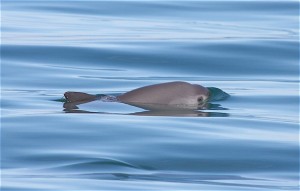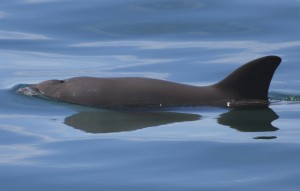
Photo credit: Photos taken under permit (Oficio No. DR/488/08) from the Secretaria de Medio Ambiente y Recursos Naturales (SEMARNAT), within a natural protected area subject to special management and decreed as such by the Mexican government.
In the Gulf of California, the body of water between Mexico’s mainland and the Baja California Peninsula, exists the Vaquita.
Now what is the Vaquita you ask? Depending on your persuasions the name brings to mind different things. Possibly it’s a fancy cocktail drink that clubbers order, “I’ll take another Vaquita on the rocks please.” Or it sounds like it could be a counter culture vampire sect whose members are in touch with their feminine side, spending more time reading romance novels and less time feeding.
Neither is right. Vaquita is actually Spanish for little cow, but it’s not a cow, not even close in my opinion. Whoever came up with little cow…well let’s just say I would like to try whatever they were smoking.
The Vaquita, or Phocoena sinus, is actually a tiny porpoise that looks like a stout torpedo wearing black lipstick and eye-liner. The Cetos Research Organization aptly describes this distinct coloring as goth make-up. This goth look features dark black circles around the eyes set in a gently sloped head that abruptly ends with plump black lips. The rest of the body is slate gray accentuated by a prominent dorsal (back) fin, which is larger compared to other porpoises and curved like a dolphin’s.
And just to be safe, here’s a quick recap on the differences between dolphins and porpoises. Dolphins have a curved dorsal fin, a beak (most of the time) and cone-shaped teeth while porpoises have a triangular dorsal fin, no beak and spade-shaped teeth.
But porpoises are truly in a league of their own. Members of the very small family Phocoenidae, there are only six species of porpoise in the world. And the Vaquita holds a unique place within this tiny family with its distinct coloring, sizable dorsal fin and very limited range. The Vaquita was first acknowledged to exist by scientists in 1958, but actual research and sighting surveys didn’t take place until 1985 according to the Guide to Marine Mammals of the World.
As adults, Vaquitas average around 4.5 feet and seem to travel in pairs. But very little is known about their traditions and behavior because they surface quickly, are easily missed between the waves and tend to keep a low-profile.
Typically, keeping a low-profile as an animal is a good thing. It’s easier to blend in with your environment, predators and prey don’t really notice you and this means you can eat well and live in peace. Until you accidentally swim into a gillnet that is.
Thanks to gillnet fishing there are only 125 to 150 Vaquita porpoises left, giving the Vaquita the dubious distinction of being the most endangered marine mammal in the world.
According to Thomas Jefferson, a marine mammal biologist with the National Marine Fisheries Service in La Jolla, gillnets have been around for close to 100 years in one form or another.
“The current type of gillnets being used are made of monofilament or plastic and it’s not clear why, but for some reason this material is harder for marine mammals to detect than other materials,” said Jefferson. “What happens is the Vaquitas are swimming around looking for food and blunder into the nets.”
Jefferson explained that gillnets are set-up like volleyball nets within the water column allowing fishermen to catch fish that try to pass through. Once a fish realizes its mistake, it tries to back out and ends up becoming caught on the net lining by its gills, hence the name. But Vaquitas also become trapped in the nets by their flippers or dorsal fins.
“The whole net sinks to the bottom and sits like a vertical panel, which is left in the water for several hours,” said Jefferson. “By the time the net is brought up, it’s too late and the Vaquita have suffocated and drowned.”
And now the Vaquita’s preference for keeping a low-profile is making scientists’ efforts to document the species difficult, but not impossible. In October 2008, Jefferson and several other scientists went to Mexico and successfully observed 13 groups of Vaquitas and snapped more than 1,600 photos.
At first scientists weren’t sure that using photo identification would be effective because this type of process only works for animals that have distinct markings and from afar Vaquitas all looked very similar. But the photographic results were exciting because many of the porpoises had unique nicks and marks on their dorsal fins making photo identification a good option for long-term studies. Some Vaquitas identified include Nicola, Topnick, Midnick and Fingertip, each name inspired by a distinct dorsal fin.

Photo credit: Photos taken under permit (Oficio No. DR/488/08) from the Secretaria de Medio Ambiente y Recursos Naturales (SEMARNAT), within a natural protected area subject to special management and decreed as such by the Mexican government.
Despite the Vaquita’s most endangered marine mammal in the world status, little research has been done since the study a year ago.
“We don’t know what is really going on since the survey cruise finished,” said Jefferson. “We have had trouble getting funding for additional research because of other things going on, the economy, swine flu. But we really want to make it happen.”
The economy has also put another critical link to the Vaquita’s survival on hold. A program was setup by the Mexican government to rescue the Vaquita and buy out local fishermen to reduce the use of gillnets.
“Their budget was cut by 40% this year and these are the things that can easily cause the species to slip into extinction,” said Jefferson. “The Vaquita could go extinct in a couple of years. We don’t have time to waste. Delay, delay, delay, caused the Baiji to go extinct, there’s no time to delay in this case.”
Here Jefferson references the recent tragedy of the Baiji, the Chinese name for the Yangtze River Dolphin. This freshwater dolphin met an untimely demise in 2006 after years and years of warnings voiced by scientists and conservationists. These cries for help were met by inaction and ultimately led to the end of a species. (For more information on the story of the Baiji check out the book Witness to Extinction: How We Failed to Save the Yangtze River Dolphin by Samuel Turvey.)
So in the case of the Vaquita there is no time to waste!
Jefferson remains hopeful that the Vaquita can be saved. “If you go down to where these animals live near San Felipe, you’ll see that it’s not a major industrial area, there’s no major pollution, the area is in really good shape, except for these gillnets, which are really the problem,” said Jefferson. “If we can just remove gillnets from the area where Vaquitas live there is a chance for recovery.”
The only place in the world where Vaquitas live is just a six hour drive away! If you want to get involved and help save the Vaquita visit www.vivavaquita.org to find out more information and take action. The most endangered marine mammal in the world needs our help. Don’t let this goth make-up fashionista go out of style.
Viva Vaquita!
Another great post! We need to save the Vaquita asap. I think with technology today we can come up with a different gillnet. Come on fishermen, put your heads together.
Carolyn,
Great work! I enjoyed reading it. Bryan, scientists are indeed working on ways to divert vaquitas away from gill nets, such as “pingers”, which emit a sound to alert the porpoises to their presence, but… it’s still a work in progress.
I love your blog, Carolyn. Thank you for inviting me to read the article – keep ’em coming! Well done…
See you soon,
Cheryl